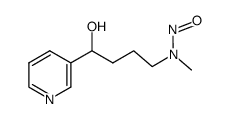Use of precision-cut tissue slices in organ culture to study metabolism of 4-(methylnitrosamino)-1-(3-pyridyl)-1-butanone (NNK) and 4-(methylnitrosamino)-1-(3-pyridyl)-1-butanol (NNAL) by hamster lung, liver and kidney.
E Richter, S Friesenegger, J Engl, A R Tricker
Index: Toxicology 144(1-3) , 83-91, (2000)
Full Text: HTML
Abstract
The pharmacokinetics of in vitro metabolism of the tobacco-specific nitrosamine, 4-(methylnitrosamino)-1-(3-pyridyl)-1-butanone (NNK; concentration range 0.03-250 microM) and its proximal metabolite, 4-(methylnitrosamino)-1-(3-pyridyl)-1-butanol (NNAL; 0.04-250 microM), were determined in Syrian golden hamster liver, lung, and kidney tissue slices in organ culture under identical experimental conditions. In the lung, a target organ for NNK animal carcinogenesis, total NNK metabolism was relatively low (maximum 23%) and oxidative metabolism by alpha-hydroxylation to DNA-reactive intermediates accounted for 13-31% of metabolism. The liver, a non-target organ for NNK carcinogenesis, showed the highest capacity to metabolise NNK (total metabolism 80%), and alpha-hydroxylation accounted for 12-25% of metabolism. The kidney, another non-target organ, also showed a low capacity for NNK metabolism (maximum 32%) and alpha-hydroxylation accounted for <3% of metabolism. Detoxification of NNK by pyridyl N-oxidation was similar in lung (5-22%) and liver (5-23%), and negligible in kidney (<2%), while carbonyl reduction of NNK to NNAL was greatest in the kidney (95-100%), followed by liver (59-79%) and lung (47-81%). NNAL is devoid of biological activity in the hamster and total metabolism was about tenfold lower than that of NNK in all tissues (<13% liver; <4% lung and kidney). In the liver, alpha-hydroxylation was the predominant pathway of NNAL metabolism at almost all concentrations (31-68% of total metabolism), whereas N-oxidation prevailed in the kidney (47-68%). In the lung, a concentration dependent decrease in the relative amount of alpha-hydroxylation (23-72%) with increasing NNAL concentrations occurred at the expense of N-oxidation (25-72%). Little or no metabolism of NNAL back to NNK was evident in any tissue.
Related Compounds
| Structure | Name/CAS No. | Molecular Formula | Articles |
|---|---|---|---|
 |
nnal
CAS:76014-81-8 |
C10H15N3O2 |
|
Quantitation of metabolites of 4-(methylnitrosamino)-1-(3-py...
2002-01-01 [Cancer Res. 62(1) , 129-34, (2002)] |
|
Evidence for endogenous formation of N'-nitrosonornicotine i...
2009-01-01 [Nicotine Tob. Res. 11(1) , 99-105, (2009)] |
|
Comparative metabolism of the tobacco-related carcinogens be...
1997-02-01 [Drug Metab. Dispos. 25(2) , 154-62, (1997)] |
|
Preparation of pyridine-N-glucuronides of tobacco-specific n...
2001-05-01 [Chem. Res. Toxicol. 14(5) , 555-61, (2001)] |
|
Effects of long term dietary phenethyl isothiocyanate on the...
1997-09-01 [Carcinogenesis 18(9) , 1715-22, (1997)] |